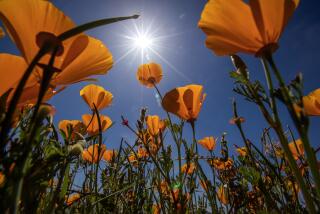SEPTEMBER IN YOUR GARDEN : START PLANTING WITH SOUTH AFRICAN BULBS
- Share via
Many South African bulbs can be planted this month. Impossible to find only a few years ago, South African bulbs are now easier to obtain. As a group, they differ from most bulbs in that they will persist for years in Southern California gardens, where the climate is similar to that of their native land. However, don’t expect the same kind of show that you’d get from tulips or daffodils. The flowers of South African bulbs are smaller, their plants more dainty.
But not homerias, with flowers that are two inches across and appear atop stems that often attain a height of two feet. A single small corm will multiply in place and become a dense clump within a few years. Or you can plant several corms in a pocket of soil for even faster service. Cover the corms with two inches of soil. Pictured at right is the common Homeria breyniana Aurantiaca; the shorter, yellow H. ochroleuca is also available.
Freesias are the best known of the South African bulbs, but the new double Dutch hybrids are much improved. Not merely because they are double-flowered, with one tubular flower tucked neatly inside another, but also because the colors are sumptuous and the flowers are fragrant and long-lasting. They persist better in the garden than the older, single varieties--with the exception of the single whites, which multiply and naturalize nicely. And despite the weight of the flowers, these freesias are less likely to lie on the ground, because the stems are sturdier. Cover the corms with two to three inches of soil, and space them in small clumps just inches apart. They look especially nice near a door or a path, where their fragrance can be appreciated.
Ixias open only when the weather is bright and sunny. Nicknamed “wandflowers,” they are unusually graceful plants. Clusters of flowers are on 18 - to 24 - inch stems that seem too delicate to support them. Their leaves are grassy and stiffly upright. Ixias look best when they’re planted in tall, weedy grass, but since that isn’t likely on most properties, try them instead in clumps of several corms tucked here and there in the garden. Cover the corms with two inches of soil.
Sparaxis and tritonias look best planted in masses. Plant 50 or so corms in a small area, space them two to three inches apart and cover them with two inches of soil. They’ll bloom for a month, creating the appearance of the South African veld in full flower.
Should you feel ready for even greater challenges with South African bulbs (or if you cannot find those mentioned here), try Burkard Nurseries, 690 N. Orange Grove Blvd., Pasadena; telephone (818) 796-4355. They specialize in bulbs. BRIGHT-YELLOW ACCENT FOR A CLOUDY DAY
Several perennial flowers bloom so early in the new year that they should be planted as early as possible in the fall. One of our favorites is yellow flax, Reinwardtia indica , pictured at left. That it is not available at every nursery is a shame, because it flowers in the dead of winter when there is no competition--a bright splash of yellow for cloudy days. But with the growing interest in perennials, perhaps it will be more available this year. If you can’t find it, try one of the nurseries listed in our article on perennials (April 14) .
Although yellow flax is a true perennial that grows from a slowly spreading mass of roots, it looks more like a shrub--three feet tall and easily that wide. It will grow in sun or partial shade, blooming for a month or two beginning in December or January. It seems to do best if the stems are cut almost to the ground after flowering; new growth will shoot up in spring and will be green and bushy all summer.
Fall is the time the prettiest flowers of the year go into the ground--those that bloom during the spring months--and it’s the time to plant bulbs and cool-season vegetables. But don’t be in a rush; September with its last-gasp hot spells is tough on newly planted trees and shrubs--or lawns. Plant only what needs to go into the ground early--such as the South African bulbs and the cole crops--and save the rest for planting in October and November.






